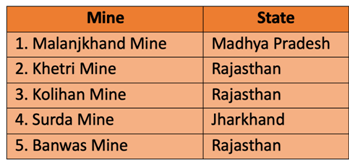India to send Delegation for Copper Mining Opportunities in Zambia
22-01-2024
02:55 PM
1 min read

What’s in Today’s Article?
- Why in News?
- About Copper Mining (Basics, Methods of Mining, Statistics on Copper Reserves, Applications, etc.)
- Applications of Copper
- Copper Mining in India
- News Summary

Why in the News?
- The Ministry of Mines has proposed sending an Indian industry delegation to copper-rich Zambia to discuss potential copper exploration and mining projects in the African country.
About Copper Mining
- Copper is a chemical element with a distinctive reddish-brown colour. It is an excellent conductor of electricity and heat.
- Copper is found in various ores in the Earth's crust. Common copper minerals include chalcopyrite, bornite, chalcocite, and malachite.
- Copper mining involves several stages, from the discovery of copper deposits to the extraction and processing of the metal.
- There are various mining methods used for extracting copper, and the choice depends on factors such as the depth of the deposit, the type of ore, and economic considerations.
- Open-Pit Mining: Used for shallow deposits. Large pits are excavated, and ore is extracted from the surface.
- It accounts for 80% of all copper mining operations in the world.
- Underground Mining: Used for deeper deposits. Shafts or tunnels are dug to reach the ore underground.
- Open-Pit Mining: Used for shallow deposits. Large pits are excavated, and ore is extracted from the surface.
- Chile is the top copper producer in the world, with 27% of global copper production.
- Chile is followed by another South American country, Peru, responsible for 10% of global production.
Applications of Copper
- Electrical Conductors: Copper is widely used in electrical wiring and components due to its excellent conductivity.
- Piping and Tubing: It is commonly used in plumbing for pipes and tubing.
- Alloys: Copper is alloyed with other metals to create alloys such as brass (copper and zinc) and bronze (copper and tin), both of which have various industrial and artistic applications.
- Electronics: Copper is used in electronic devices, printed circuit boards, and other electronic components.
- Roofing and Architecture: Copper is used in roofing materials and architectural applications due to its corrosion resistance and aesthetic appeal.
Copper Mining in India
- There are approximately 700 copper mines in operation globally, of which 127 are in India.
- However, India is poor in terms of copper reserves & production.
- India has low-grade copper ore (less than 1% metal content) compared to the international average of 2.5%.
- Madhya Pradesh is the leading producer of copper in India. It accounts for producing 53% of copper in this country.
- Rajasthan accounts for 43%, and Jharkhand accounts for 4% of copper production in India.
News Summary
- The Ministry of Mines has proposed sending an Indian industry delegation to copper-rich Zambia to discuss potential copper exploration and mining projects in the African country.
- Zambia has about 6% of the world’s copper reserves and was the eight-largest producer of copper in 2022.
- As per International Copper Association India, domestic copper demand grey by 16 per cent in FY2022-24, while demand for copper in clean energy technologies grew by 32 per cent.
- At the same time, net imports of copper cathode, which is the basic product of copper production, grew by 180 per cent in the same financial yeas as India is not self-sufficient in copper due to low domestic reserves.
- Currently, India has a limited presence in Zambia’s copper mining sector. Also, India is not alone in investing in Zambia for its copper reserves.
- Canada’s First Quantum Minerals and China’s CNMC are among the largest producers of copper in Zambia.
- Among the interested companies to explore mining opportunities in Zambia is Vedanta-owned Hindustan Zinc, in which the Indian government also owns a 35 per cent stake.
Q1) What is the process of Fracking?
Fracking is the process of injecting liquid at high pressure into subterranean rocks, boreholes, etc. so as to force open existing fissures and extract oil or gas.
Q2) What is Deep Sea Mining?
Deep sea mining is the extraction of minerals from the ocean floor found at depths of 200 metres to 6,500 metres. As of 2021, the majority of marine mining efforts were limited to shallow coastal waters, where sand, tin and diamonds are more readily accessible.
Source: India to send industry delegation for copper mining opportunities in Zambia | Mines.gov


